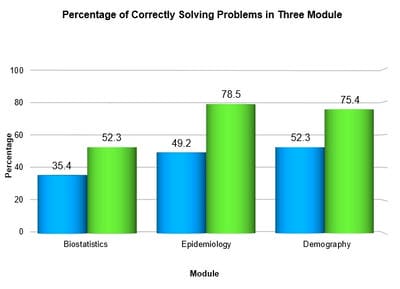Item test analysis to assess the difficulty index for biostatistics, epidemiology, and demography module of undergraduate medical students of Raipur, Chhattisgarh, India
Verma N.1, Shinkar S.2*, Jain K.3
DOI: https://doi.org/10.17511/ijphr.2020.i06.04
1 Nirmal Verma, Professor, Department of Community Medicine, Pt. J. N. M. Medical College, Raipur, Chhattisgarh, India.
2* Swapnil Shinkar, Statistician Cum Lecturer, Department of Community Medicine, Pt. J. N. M. Medical College, Raipur, Chhattisgarh, India.
3 Kamlesh Jain, Professor, Department of Community Medicine, Pt. J. N. M. Medical College, Raipur, Chhattisgarh, India.
Background: “Psychometry” has been developed as a branch of psychology that deals with the measurement of psychological traits or mental abilities like intelligence, aptitude, opinion, interest, personality, or scholastic achievement. Term Examination or Test series are being increasingly used in such an assessment. “Item Analysis” examines student responses to individual test items to assess the quality of those items and test as a whole to improve or revise items and the test. Objective: To assess the difficulty Index of third-year undergraduate students towards the biostatistics, epidemiology, and demography module. Materials and Methods: This is a cross-sectional observational study was conducted among 130 undergraduate medical students for Internal and External examination using a set of 3 questions related to the Biostatistics, Epidemiology and Demography module after 25 hours of teaching. Data were collected and entered in Microsoft Excel and analyzed using IBM SPSS version 23.0 software. Results: The majority of study subjects were females (57.7%), Hindu by religion (90.0%), studied in English Medium School (79.2%). Only 14.6% of them took Biology with Mathematics subjects during higher secondary studies. Approximately 52.3%, 78.5%, and 74.5% of study subjects correctly solved questions of Biostatistics, Epidemiology, and Demography in the External Examination. The Difficulty of Biostatistics relative to Epidemiology was 7.3 times higher than the Epidemiology relative to Demography in the External Examination. Conclusion: Biostatistics module was more difficult than other modules for Undergraduate medical students.
Keywords: Difficulty Index, Biostatistics, Epidemiology, Demography
| Corresponding Author | How to Cite this Article | To Browse |
|---|---|---|
| , Statistician Cum Lecturer, Department of Community Medicine, Pt. J. N. M. Medical College, Raipur, Chhattisgarh, India. Email: |
Verma N, Shinkar S, Jain K. Item test analysis to assess the difficulty index for biostatistics, epidemiology, and demography module of undergraduate medical students of Raipur, Chhattisgarh, India. Public Health Rev Int J Public Health Res. 2020;7(6):66-70. Available From https://publichealth.medresearch.in/index.php/ijphr/article/view/150 |


 ©
© 